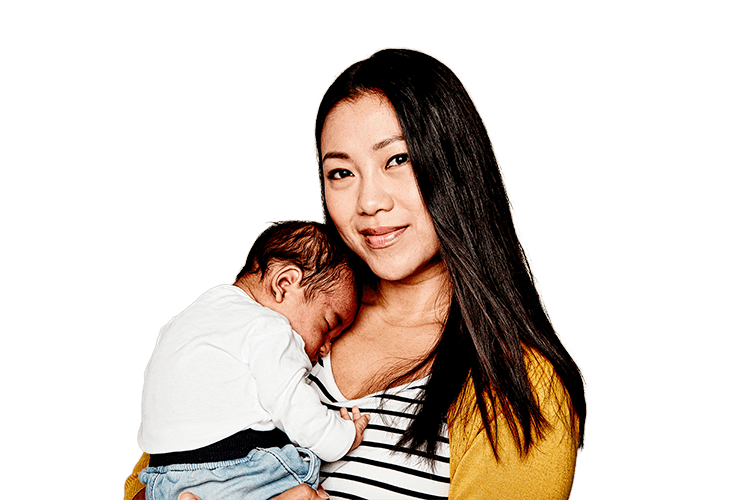
How to pick up and hold your newborn
It can be quite frightening when handling a newborn infant, due to how soft and floppy their neck is at the beginning. It’s important to remember when picking up and holding your baby to always support their head, especially around the fontanelles (the soft spots on top of their head).
How to pick up a newborn:
- Slide one hand under their head, with your other hand under their bottom.
- Bend your knees as you lower your arms to protect your back.
- Scoop the baby up and bring them close to your chest, as you straighten your legs.
How to hold a newborn:
- Ensure that the baby’s head is resting on your chest and slide your hand up from their bottom to their neck for additional support.
- Move the baby to the crook of your arm and put your other hand under their bottom.
- Your baby should now be in a cradle hold. This allows you to see your baby and talk to him or her as you please.
How to massage
Giving your baby a 10-30 minute baby massage is a great way to bond with, and soothe your child. The best time to give your baby a massage is after they have had a nap. To prevent an allergic reaction, you should test your massage oil or moisturiser on your baby prior to giving them the massage.
- Ensure that the area you’re using is quiet, comfortable, safe and clean.
- Make sure you and your baby are alert and relaxed.
- Put a few drops of massage oil or unfragranced moisturiser into your hands and massage it gently into the soles of their feet slowly, from heel to toe.
- Using more oil, do long smooth strokes up the length of the leg from ankle to thigh and over hip, avoiding the genitals. You can help to release any wind by holding your baby’s leg under the knee and gently pressing it towards their stomach.
- Continue with gentle strokes on the shoulders, moving your hands towards the chest.
- Move to the arms, stroking down from the shoulders to the wrists. Avoid getting oil on your baby’s hands as they are likely to ingest it.
- Only massage your baby’s stomach if it is soft to the touch, and do so with circular, clockwise strokes. If baby’s cord hasn’t healed yet, or they become agitated, move onto the next step. Do not massage or put any pressure on the baby’s diaphragm.
- Using your finger pads, stroke from the middle of baby’s forehead, down to the outside of their face and towards their cheeks. You can also massage the scalp in small circles.
- If your baby is still relaxed and is enjoying the massage, you can turn them over onto their stomach and use long, smooth strokes from head to toe.
How to burp
Wind in newborns is very common, as they often swallow air when crying or feeding. Burping your baby will help with the removal of this wind and is a necessary conclusion to feeding.
- Put a cloth over your shoulder, to prevent your clothes from being stained.
- Put baby over your shoulder with your arm from that side of your body supporting their bottom.
- Gently rub your baby’s back with your other hand and wait for the wind to pass.
How to trim baby nails
As intentional movement does not come until your baby is around 4-6 months, you will need to ensure your baby’s nails are managed and kept short to prevent injury. The nails of a newborn are soft, but they grow fast so you will need to trim both their fingernails and toenails regularly.
- Prepare your utensils: either special baby nail clippers, baby nail scissors or an emery board.
- Make sure there is plenty of light and you have someone else to hold the baby as you trim their nails.
- Take your time with both the fingernails and nails, to ensure you trim them without cutting or damaging the finger pads or surrounding skin.
- Sing to your baby to keep them calm and praise them when you’re finished, to ensure the experience is a positive one.
How to change a nappy
Changing your baby’s nappy is one of the most common tasks you will do as a new parent. There are two different kinds of nappies: disposable and cloth, however the initial steps for changing a nappy remain the same.
Preparing to change
- Ensure that your change area is clean and that you have everything you need within easy reach: a fresh nappy, baby cream, baby wipes or washcloths and water.
- Lay the baby down on the changing mat, surface, or change table. If the baby is upset, you can sing or offer him or her a favourite toy to soothe them.If the baby is on an elevated surface, ensure that you keep one hand on your baby at all times.
- Undress your baby’s bottom half and unfasten the nappy. Use the front of the dirty nappy to wipe away any poo, then wrap the nappy up tightly ready for disposal or washing.
Cleaning a baby’s bottom
- Using baby wipes, a damp washcloth or wet cotton wool, gently clean your baby’s bottom.
- Hold the baby by the legs with your fingers between the ankles, to clean the back of their bottom - always wiping front to back.
- You can dry the baby’s skin by gently patting it, or leaving it to air-dry for a few moments.
- Apply baby cream to prevent and reduce nappy rash. Do not use talcum powder.
Putting on a clean disposable nappy
- Open a clean nappy, ensuring that fastening tabs are towards the top.
- Lifting the baby up the ankles, slip the nappy beneath their bottom, fold the front flap up, ensure it fits firmly around the baby’s waist and fasten each tab. If the nappy is secured properly, you should be able to fit two fingers into the waistband. Do not cover the belly button in newborns.
- Let the baby play in a bouncer, cot or on a clean blanket or area on the floor, whilst you dispose of the dirty nappy and wash your hands.
Putting on a clean cloth nappy
- Taking a new cloth nappy and a liner, slip it under the baby and fasten using clips, velcro or press studs. Be careful not to cover the belly button in newborns. Make sure the nappy is not too tight by ensuring that you can fit two fingers in the waistband.
- To avoid leaks, make sure you cover the whole nappy with a nappy cover.
Armed with this information, you should now be able to expertly pick up, hold, burp, nappy change and massage your newborn, as well as tend to his or her nails. Knowing how to facilitate, and supporting your partner in, the daily care of your newborn baby is an important step to working together as a team and making the most of this special time.
Need a little extra support?
Sleep and settling
Our sleep and settling support line, delivered by Tresillian’s specialist nurses, is here to help eligible members with hospital cover, at no extra cost on 1800 973 573.∓
Medibank Mental Health Phone Support
Members with Hospital cover can talk with a mental health professional over the phone in relation to any mental health or emotional concern, 24 hours a day 7 days a week by calling 1800 644 325.~
Health Concierge
Eligible members with hospital cover can now talk to a member of our Health Concierge team for advice on how to have a healthy pregnancy, at no extra cost on 1800 789 414.#
Looking for something else?
Visit Medibank Planning, Pregnancy and Parenting for a range of tools and advice to help you at every stage of your pregnancy journey.
Help the way you want it
Contact us
Call us on 134 190 to speak to a consultant. Alternatively, chat to us 24/7 online.
Self-service options
Login to MyMedibank or Download the MyMedibank App for self service options.
Find a specialist
Find a specialist or Member's choice hospital using our find a provider tool.

Things you should know
∓ The Medibank sleep support line is available to eligible members with Bronze hospital cover and above. Excludes Overseas Visitor Health Cover, Working Visa Health Cover and Overseas Student Health Cover (OSHC). Waiting periods may apply. Some referred services may involve out of pocket costs.
~ OSHC members should call the Student Health and Support Line on 1800 887 283.
# Health Concierge is available to all eligible Medibank members who hold hospital cover. Excludes Overseas Visitor Health Cover, Working Visa Health Cover and Overseas Student Health Cover (OSHC). Some referred services may involve out of pocket costs.
While we hope you find this information helpful, please note that it is general in nature. It is not health advice, and is not tailored to meet your individual health needs. You should always consult a trusted health professional before making decisions about your health care. While we have prepared the information carefully, we can’t guarantee that it is accurate, complete or up-to-date. And while we may mention goods or services provided by others, we aren’t specifically endorsing them and can’t accept responsibility for them. For these reasons we are unable to accept responsibility for any loss that may be sustained from acting on this information (subject to applicable consumer guarantees).